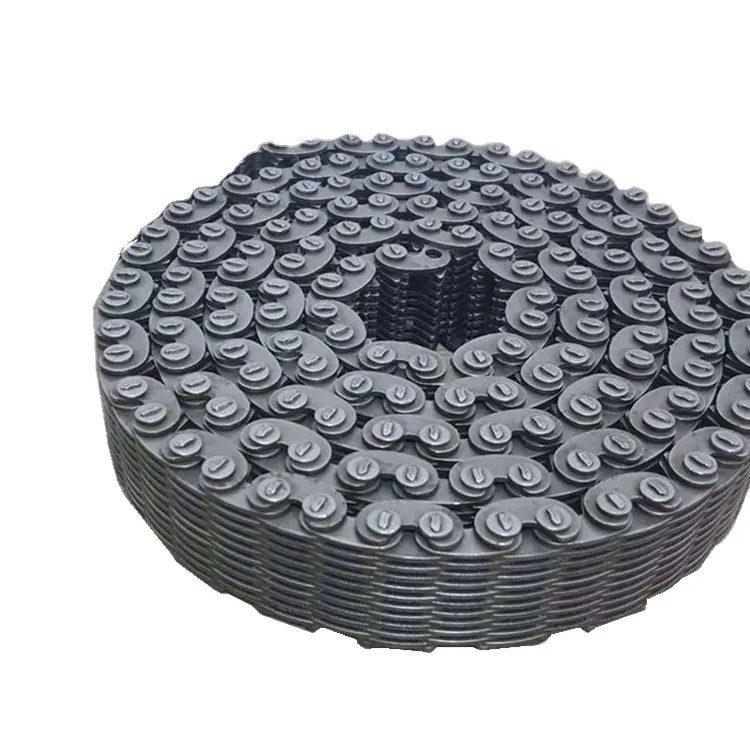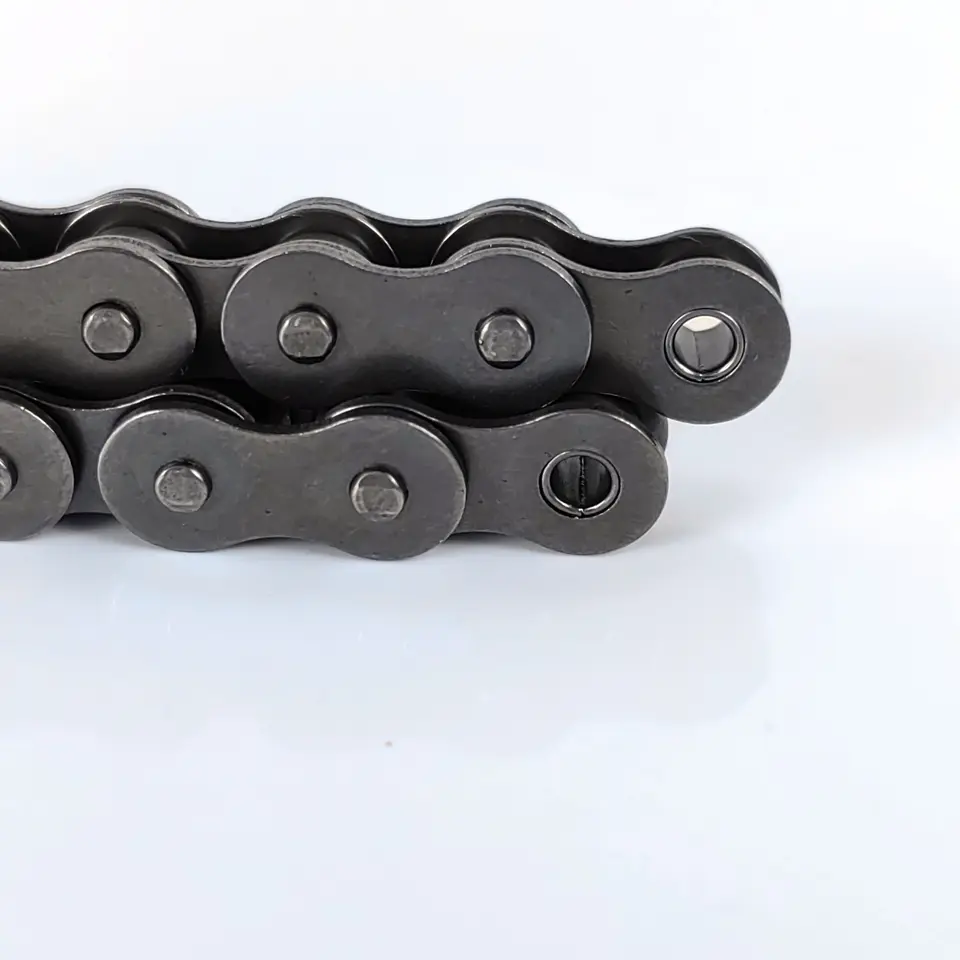Product Description
Product Description
1. Standard : ISO /DIN /ANSI
2. Model : 25-1; 35-1; 40-1; 50-1; 60-1; 80-1; 1/8822 0571 -57152031 Fax: 86~/8822 0571 -57152030
Http://kasinchain
| Standard or Nonstandard: | Standard |
|---|---|
| Application: | Textile Machinery, Garment Machinery, Conveyer Equipment, Packaging Machinery, Electric Cars, Motorcycle, Food Machinery, Marine, Mining Equipment, Agricultural Machinery, Car |
| Surface Treatment: | Oil Blooming |
| Structure: | Roller Chain |
| Material: | Alloy |
| Type: | Short Pitch Chain |
| Samples: |
US$ 1.00/Meter
1 Meter(Min.Order) | |
|---|
| Customization: |
Available
| Customized Request |
|---|

What are the noise levels associated with a motor chain?
The noise levels associated with a motor chain can vary depending on various factors:
1. Chain Design:
The design of the motor chain, including the type of links and the pitch, can influence the noise levels. Chains with precision-formed and accurately machined components tend to produce less noise compared to chains with rough or uneven surfaces.
2. Lubrication:
Proper lubrication of the motor chain is essential to reduce friction and noise. Insufficient or improper lubrication can result in increased friction, leading to higher noise levels. Regular lubrication with suitable lubricants can help minimize the noise generated by the chain.
3. Tension and Alignment:
A motor chain that is improperly tensioned or misaligned can produce excessive noise. It is important to ensure that the chain is properly tensioned and aligned to minimize noise generation.
4. Wear and Maintenance:
As a motor chain wears over time, it may develop loose links or damaged components, leading to increased noise during operation. Regular maintenance and timely replacement of worn-out parts can help prevent excessive noise levels.
5. Surrounding Environment:
The noise levels in the surrounding environment can also affect the perceived noise from the motor chain. Other machinery, equipment, or environmental factors can contribute to the overall noise levels in the area.
Overall, the noise levels associated with a motor chain can be minimized through proper chain design, adequate lubrication, correct tensioning and alignment, regular maintenance, and a well-controlled surrounding environment. It is important to follow manufacturer guidelines and recommendations for noise reduction techniques and use appropriate noise-dampening measures if necessary.

How do you properly lubricate and maintain a motor chain?
Proper lubrication and maintenance are essential for ensuring the optimal performance and longevity of a motor chain. Here are the steps to properly lubricate and maintain a motor chain:
1. Clean the chain: Before lubricating, clean the motor chain to remove any dirt, debris, or old lubricant. Use a suitable cleaning agent and a brush or cloth to gently scrub the chain. Ensure that the chain is completely dry before proceeding.
2. Choose the right lubricant: Select a lubricant specifically designed for motor chains. Consider factors such as the operating conditions, temperature, and load requirements when choosing the lubricant. Consult the manufacturer’s recommendations or seek professional advice if necessary.
3. Apply the lubricant: Apply the lubricant evenly to the entire length of the motor chain. Use a suitable applicator or a spray bottle to ensure thorough coverage. Pay special attention to the contact points between the chain and the sprockets.
4. Remove excess lubricant: After applying the lubricant, allow it to penetrate the chain for a few minutes. Then, use a cloth or rag to wipe off any excess lubricant. This helps prevent the accumulation of dirt and debris on the chain.
5. Regular inspection: Regularly inspect the motor chain for signs of wear, corrosion, or damage. Look for elongation, cracked plates, damaged pins, or excessive play. If any issues are found, take appropriate action, such as replacing the chain or repairing the damaged components.
6. Tension adjustment: Check the tension of the motor chain regularly. Improper tension can cause excessive wear and reduce the chain’s performance. Follow the manufacturer’s guidelines or consult a professional to ensure proper tensioning.
7. Schedule maintenance: Establish a maintenance schedule for the motor chain. This includes regular cleaning, lubrication, inspection, and any necessary adjustments or replacements. Adhere to the schedule to keep the chain in optimal condition.
By following these steps and maintaining a regular maintenance routine, you can maximize the performance and service life of your motor chain.

What are the different types of motor chains available?
Motor chains come in various types, each designed to meet specific requirements of different applications. Here are some common types of motor chains:
1. Roller Chains: Roller chains are the most common type of motor chain. They consist of inner and outer plates connected by rollers. These chains are known for their high strength, durability, and ability to handle heavy loads. Roller chains are widely used in industries such as automotive, industrial machinery, and agriculture.
2. Silent Chains: Silent chains, also known as inverted-tooth chains, feature tooth-shaped plates that engage with each other. They provide smooth and quiet operation, making them suitable for applications requiring low noise levels. Silent chains are commonly used in precision machinery, printing presses, and automotive timing systems.
3. Leaf Chains: Leaf chains have flat, interlocking plates connected by pins. They are primarily used in lifting and hoisting applications, such as forklifts and cranes. Leaf chains are known for their high tensile strength and resistance to fatigue.
4. Conveyor Chains: Conveyor chains are specifically designed for conveying materials in conveyor systems. They feature large, wide plates to support the load and provide smooth movement. Conveyor chains are used in industries such as mining, food processing, and packaging.
5. Timing Chains: Timing chains are used in engines to synchronize the rotation of the crankshaft and camshaft. They have precise tooth profiles that ensure accurate timing of valve operation. Timing chains are commonly found in automotive engines and other internal combustion engines.
6. Specialty Chains: There are also specialized motor chains designed for specific applications. Examples include escalator chains, bicycle chains, motorcycle chains, and marine chains.
Motor chains are available in different sizes, materials, and configurations to suit specific requirements. It is important to select the appropriate chain type based on factors such as load capacity, speed, environment, and application-specific needs.


editor by CX 2023-10-20